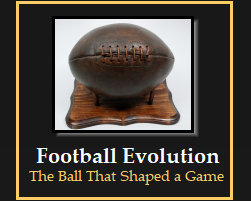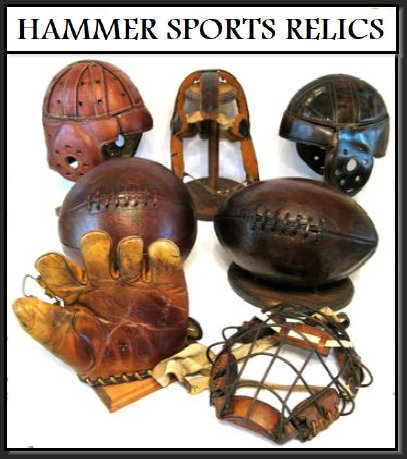March 2016
Hammer Sports Relics'
Late 19th Century Association & Rugby Balls

Questions or comments? Please email me at:
In June of 2015, we posted a story on how the football got its shape and evolved along with America's most popular sport. Two balls recently acquired and restored by Steve Hill of Hammer Sports Relics provide a rare glimpse at the modern football's earliest ancestors.
In 1863 the English game of "football" split into two distinct sports, association football (soccer) and rugby football. Designed for a kicking game, association footballs would remain spherical while the rugby football was elongated into a prolate spheroid to make the ball easier to carry, and more aerodynamic when pitched or tossed.
In 1863 the English game of "football" split into two distinct sports, association football (soccer) and rugby football. Designed for a kicking game, association footballs would remain spherical while the rugby football was elongated into a prolate spheroid to make the ball easier to carry, and more aerodynamic when pitched or tossed.
By the mid-1870's, English association and rugby balls were being imported to America. In fact, no American sporting goods company would mass produce footballs domestically until 1892, when A.G. Spalding began manufacturing footballs using imported English leather. Association footballs consisted of a rubber bladder encased within a leather shell. The shell was constructed out of eight equal leather panels with round, coin shaped patches at either end to reinforce the seams. Rugby balls were similarly constructed, but utilized four or six elongated leather panels to give the ball its prolate spheroid shape. By the late 1870's the official size of a collegiate association or rugby ball was a size five, with a 27" circumference. The Hammer Sports Relics association ball has a 22" circumference, making it a size 3 youth ball. With a 26-1/2" circumference, the 6-panel rugby ball is close to an official size 5 ball.
English Imported Foot Balls
6-Panel Footballs
In the decades before and after the turn-of-the-century, the vast majority of balls manufactured for American football were comprised of a 4-panel leather shell with a rubber bladder. While examples of 6-panel footballs can be found in early catalogs and photographs, the distinct panel pattern and kidney-shaped lace stitching extant in the Hammer Sports Relics ball doesn't match any images found in our catalog collection. Instead of all 6 leather panels meeting at the tips of the ball, the two side panels wrap around the ends and the top panels are sewn to them. This design provided a stronger and more rounded ball tip, a feature that would have given the ball a more predictable bounce when drop-kicked. It is our opinion that the ball is a rugby football manufactured in England and imported to the U.S. between 1880 and 1890. The term "rugby foot ball" was used to describe balls used in English rugby and American football until around 1910.


T.H. Prosser & Sons Ad, 1883
Spalding Football Ad, 1891
University of Michigan Team 6-Panel Ball, 1879
Association Ball
The Hammer Sports Relics association ball is more difficult to date. The 8-panel design employed in this ball was used from the early 1870's through 1920, and the ball's stitch pattern does not match any found in our catalog library. Unlike the association balls shown in later catalogs which have circular panels integrated into the eight panel pattern, the Hammer Sports Relics' ball utilizes the circular panels as patches to seal the end of the ball. The panels protrude from the side of the ball and would have affected the direction of the ball as it rolled. In light of this feature, we believe that the association ball is a mid-grade youth ball dating between 1880 and 1900.
Hammer Sports Relics is accepting offers on this pair of rare balls through March 31, 2016. Please contact Steve Hill at:
Association ball ad, Reach Fall & Winter Catalog for 1913
For Sale
HAMMER SPORTS RELICS
North Canton, Ohio
330-491-6195
North Canton, Ohio
330-491-6195







